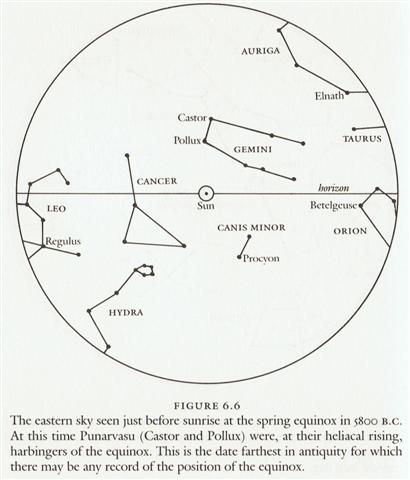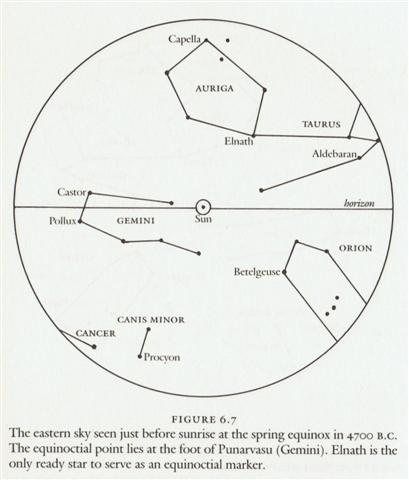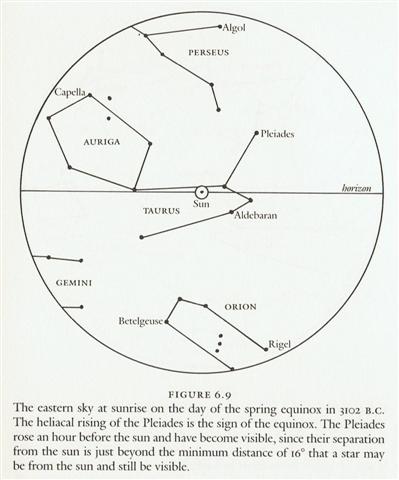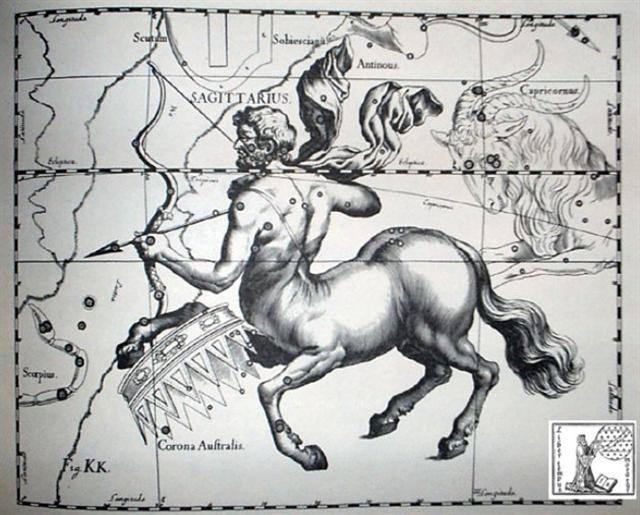Once upon a time the feet of the Gemini twins were rising at 0h. Since then (around 6h / 24h * 26,000 years ago) the precession must have pushed them forward in the year, presently to arrive just after the June solstice.
... In Hindu legend there was a mother goddess called Aditi, who had seven offspring. She is called 'Mother of the Gods'. Aditi, whose name means 'free, unbounded, infinity' was assigned in the ancient lists of constellations as the regent of the asterism Punarvasu. Punarvasu is dual in form and means 'The Doublegood Pair'. The singular form of this noun is used to refer to the star Pollux. It is not difficult to surmise that the other member of the Doublegood Pair was Castor. Then the constellation Punarvasu is quite equivalent to our Gemini, the Twins. In far antiquity (5800 B.C.) the spring equinoctial point was predicted by the heliacal rising of the Twins (see fig. 6.6). By 4700 B.C. the equinox lay squarely in Gemini (fig. 6.7).
Punarvasu is one of the twenty-seven (or twenty-eight) zodiacal constellations in the Indian system of Nakshatras. In each of the Nakshatras there is a 'yoga', a key star that marks a station taken by the moon in its monthly (twenty-seven- or twenty-eight-day course) through the stars. (The sidereal period of the moon, twenty-seven days and a fraction , should be distinguished from the synodic, or phase-shift period of 29.5 days, which is the ultimate antecedent of our month.) In ancient times the priest-astronomers (Brahmans) determined the recurrence of the solstices and equinoxes by the use of the gnomon. Later they developed the Nakshatra system of star reference to determine the recurrence of the seasons, much as the Greeks used the heliacal rising of some star for the same purpose. An example of the operation of the Nakshatra system in antiquity can be seen in figure 6.9.
Here we see that the spring equinox occurred when the sun was at its closest approach to the star Aldebaran (called Rohini by the Hindus) in our constellation Taurus. But, of course, the phenomenon would not have been visible because the star is too close to the sun for observation. The astronomers would have known, however, that the equinoctial point was at Aldebaran by observing the full moon falling near the expected date or near a point in the sky exactly opposite Aldebaran (since the full moon is 180º from the sun), that is, near the star Antares ... The system of Nakshatras, then, is quite distinct from systems that use the appearance of heliacally rising or setting stars as the equinoctial marker. Furthermore, the Indian system is all but unique in that two calendar systems competed with each other - a civil system, in which the year's beginning was at the winter solstice, and a sacrificial year, which begins at the spring equinox. The beginning of the former was determined by the Nakshatra method, observing the winter full moon's apparition near the point of the summer solstice in the sky (as explained above). The arrival of the beginning of the sacrificial year might be determined by the Nakshatra method - observation of the spring full moon near to the autumn Nakshatra in Virgo. More commonly, however, it was determined as in the Greek system, by direct observation of the heliacal rising of a sign star. In the current calendar, for example - one unchanged since the fifth century A.D. - the yoga star of the Nakshatra Ashvini (beta Arietis) ushers in the spring equinox at its heliacal rising ... The nakshatra method - by which it was possible to determine where the Sun was by looking in the night at the right ascension stars determined by the face of the Full Moon - could easily have been used by people on Easter Island. In my supporting dates I have added 183 in order to move from a nakshatra day number to its corresponding heliacal day number (or the other way around). For instance was the heliacal star position of St John's Eve (June 24) exactly half way around the year compared to the night sky of Christmas Eve, when Tejat Posterior was vertically aligned with the Full Moon. 175 (June 24) + 183 = 358 (Christmas Eve). 358 + 183 - 366 = 175. To make my method work properly we have to subtract 366 (= 2 * 183) instead of 365¼. Though had I not found evidence in the rongorongo texts for a cycle measuring 366 I would not have dared to suggest this simple and practical method. In the night sky of June 24 the stars in Sagittarius (the Archer) were close to the Full Moon, i.e. they would rise with the Sun around Christmas. The bow and quiver (cfr at Castor and Pollux) is precisely what an Archer needs, but he was absent and instead present at the opposite side of the year:
Kaus Medius is δ Sagittarii at the hand of the Archer and Kaus Australis is ε further south on his serpentine bow:
When using the nakshatra method it is useful to have associations across the sky roof. Lucia, for instance, is celebrated in the darkest of times and opposite to the season when the Sun is very high up (in the northern sky). In December 13 and close to the Full Moon were the bright and easy recognizable 3 stars in the Belt of Orion - Mintaka (δ), Alnilam (ε), and Alnitak (ζ):
Though the Chinese appear to have referred only to Alnitak in their 21st station Three Stars. More to the point, however: counting 5 days forward from Alnitak was the vertical line which at 6h (in our time) would be easy to find by looking from δ Aurigae (Praja-pāti), down to Menkalinan (β) and Mahashim (θ):
The blue descending 'river valley' of the Milky Way is today overcrossed at 6h by the blue ecliptic 'road' of the Sun (and the rest of the planets). In rongorongo times it would not have been very much different. Praja-pāti at the top of the 6h (midsummer) line means 'The Lord of Created Beings'.
There were thus 3 stars more or less horizontally oriented in the Belt of Orion and 3 stars precisely vertically oriented in Auriga, which made it possible to allude to the fact that once upon a time the 'horizontal' ecliptic road must have gone right through the 3 stars in the center of Orion at the sky equator (0º). |
|||||||||||||||||||||||||||||||||||||||||||||||||||||||||||||||||||||||||||||||||||||||||||||||||||||||||||||||||||||||||||||||||||||||||||||||||||||||||||||||||||||||||||||||||||||||||||||||||||||||||||||||||||||||||||||||||||||||||||||||||||||||










